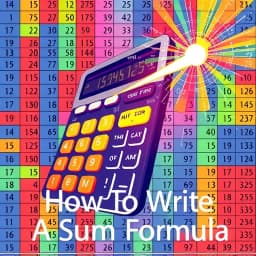
How to Write a Sum Formula in Google Sheets
Find this useful? Bookmark ( CTRL/CMD + D ) for quick access!
Try an example:
Basic Sum Calculation
Conditional Summation
Sum Across Sheets
Dynamic Range Summation
Sum with Filters
Sum with Criteria
Explore Similar Tools
Recent Generations
the amount paid directly to you. Yes it is possible in future cases to request direct payment to the provider, Rephrase and give me polished email.
we have processed the claim as per the attachments in the claim submission we have processedthe invoice for Saul Holding. We dont have invoice for the Salofalk.
this additional information is very important. this adiitional information was requested by our clinical team. Without clinical review claim not be paid so please share the below additional information
How To Write A Sum Formula In Google Sheets is a comprehensive guide designed to empower users with the knowledge to effectively utilize the SUM function in Google Sheets. This essential resource simplifies the process of summing data, making it accessible for both beginners and advanced users alike.
Key Capabilities
- Step-by-step instructions for writing a SUM formula, ensuring clarity and ease of understanding.
- Examples and use cases that demonstrate practical applications of the SUM function in various scenarios, enhancing user comprehension.
- Tips for troubleshooting common errors associated with SUM formulas, helping users resolve issues quickly and efficiently.
- Integration with other functions to create more complex calculations, allowing users to maximize their data analysis capabilities.
Who It's For
Designed for students, professionals, and anyone looking to enhance their data management skills, How To Write A Sum Formula In Google Sheets is perfect for those who frequently work with spreadsheets. Whether you're analyzing sales data or managing budgets, this guide streamlines your workflow and boosts productivity.
Why Choose How To Write A Sum Formula In Google Sheets
What sets this guide apart is its user-friendly approach and comprehensive coverage of the SUM function, making it the ideal resource for anyone looking to improve their spreadsheet skills and data analysis efficiency.
Ready to transform your spreadsheet experience? Start mastering the SUM formula in Google Sheets today and unlock the full potential of your data!
Enhance Your Work with How to Write a Sum Formula in Google Sheets
Leverage the power of AI to streamline your tasks with our How to Write a Sum Formula in Google Sheets tool.
Step-by-Step Guidance
Receive detailed instructions on how to write and implement SUM formulas in Google Sheets, ensuring you understand each step.
Educational Resources
Access a variety of tutorials and examples that enhance your understanding of using SUM formulas effectively in your spreadsheets.
Interactive Support
Get real-time assistance and tips while you work on your Google Sheets, making it easier to troubleshoot and optimize your formulas.
How How to Write a Sum Formula in Google Sheets Works
Discover the simple process of using How to Write a Sum Formula in Google Sheets to improve your workflow:
Open Google Sheets
Start by launching Google Sheets and opening the spreadsheet where you want to write the SUM formula.
Select the Cell
Click on the cell where you want the result of the SUM formula to appear.
Enter the SUM Formula
Type the SUM formula in the selected cell, using the syntax =SUM(range) to sum the desired range of cells.
Review the Result
Press Enter to execute the formula and review the calculated sum displayed in the cell.
Use Cases of
How to Write a Sum Formula in Google Sheets
Explore the various applications of How to Write a Sum Formula in Google Sheets in different scenarios:
Budget Tracking
Utilize the SUM formula in Google Sheets to track monthly expenses and income, allowing users to maintain a clear overview of their financial health.
Sales Performance Analysis
Employ the SUM formula to aggregate sales data over specific periods, helping businesses evaluate performance and make informed decisions.
Project Cost Estimation
Use the SUM formula to calculate total project costs by summing individual expense categories, ensuring accurate budgeting and resource allocation.
Inventory Management
Implement the SUM formula to keep track of stock levels by summing quantities of items received and sold, aiding in effective inventory control.
Who Benefits from How to Write a Sum Formula in Google Sheets?
AI-Powered Efficiency
From individuals to large organizations, see who can leverage How to Write a Sum Formula in Google Sheets for improved productivity:
Students
Learn how to efficiently use Google Sheets for academic projects and data analysis.
Small Business Owners
Manage finances and track expenses easily with sum formulas in Google Sheets.
Data Analysts
Streamline data calculations and enhance reporting accuracy with sum formulas.
Project Managers
Monitor project budgets and resource allocation effectively using Google Sheets.
Frequently Asked Questions
What is a SUM formula in Google Sheets?
A SUM formula in Google Sheets is a function that adds together a range of numbers. It can be used to calculate totals in a spreadsheet by specifying the cells you want to sum.
How do I write a SUM formula in Google Sheets?
To write a SUM formula, you can type '=SUM(' followed by the range of cells you want to add, and then close the parentheses. For example, '=SUM(A1:A10)' will sum all values from cells A1 to A10.
Can I sum non-contiguous cells in Google Sheets?
Yes, you can sum non-contiguous cells by separating the cell references with commas in the SUM formula. For example, '=SUM(A1, A3, A5)' will add the values in cells A1, A3, and A5.
What happens if I sum empty cells?
When you sum empty cells in Google Sheets, they are treated as zero, so they do not affect the total. The SUM function will only add the values of the cells that contain numbers.
Is there a limit to the number of cells I can sum in Google Sheets?
Google Sheets allows you to sum a large number of cells, with a maximum of 10,000 individual cell references in a single SUM function. However, the total number of cells in a spreadsheet can be much larger.
































